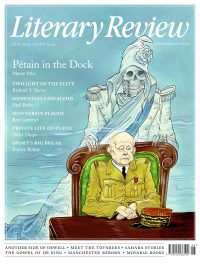Paul Genders
Crash Course
The Bee Sting
By Paul Murray
Hamish Hamilton 656pp £18.99
Paul Murray’s patter is so fluid, funny and clever that you’d be forgiven for pausing, from time to time, to double-check the quality of what you’re being sold. For most of The Bee Sting, Murray seems capable of doing anything a novelist might reasonably want to do. There’s laughter in every other line, but there’s also a compassion and a midlife wisdom at work that suggest we aren’t merely in the company of a gag merchant. He takes us into the mind of a teenage girl, Cass Barnes, and captures her apparently indiscriminate moods, as they flit between sweetness and nastiness; when he turns to her shopping- and selfie-addicted mother, Imelda, he manages to avoid caricature and draw out her dignity. As events unfold – no sentence a chore or lacking in bounce – it becomes apparent that the novel is also exceptionally smartly structured. Quirky details strike back later in the narrative, with unexpected force. One such example is the bee sting that Imelda sustained on her wedding day, which supposedly explains the lack of pictures from the occasion in the Barnes’s family photo collection.
‘A mad thing from some estate in the next town over’ is how Imelda imagines she’s perceived by her neighbours in their village, situated an hour or so from Dublin. Imelda’s early years were unpromising: her father would show videos of himself ‘pummelling strangers in a car park’

Sign Up to our newsletter
Receive free articles, highlights from the archive, news, details of prizes, and much more.@Lit_Review
Follow Literary Review on Twitter
Twitter Feed
Literary Review is seeking an editorial intern.
Though Jean-Michel Basquiat was a sensation in his lifetime, it was thirty years after his death that one of his pieces fetched a record price of $110.5 million.
Stephen Smith explores the artist's starry afterlife.
Stephen Smith - Paint Fast, Die Young
Stephen Smith: Paint Fast, Die Young - Jean-Michel Basquiat: The Making of an Icon by Doug Woodham
literaryreview.co.uk
15th-century news transmission was a slow business, reliant on horses and ships. As the centuries passed, though, mass newspapers and faster transport sped things up.
John Adamson examines how this evolution changed Europe.
John Adamson - Hold the Front Page
John Adamson: Hold the Front Page - The Great Exchange: Making the News in Early Modern Europe by Joad Raymond Wren
literaryreview.co.uk